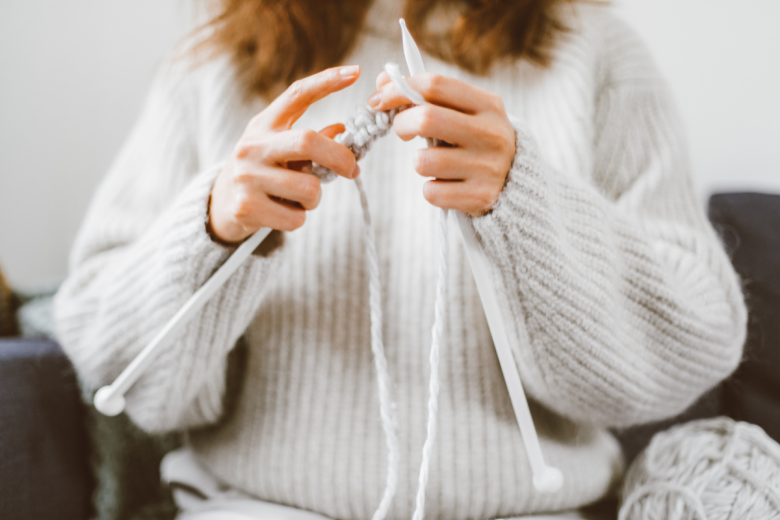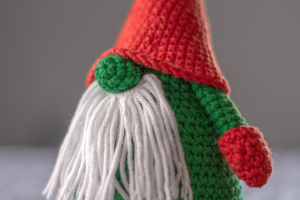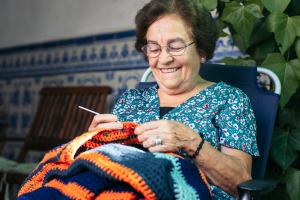The continuous knitting technique, often referred to as “knitting in the round,” is a method where you knit a project without interruption or seams. Unlike traditional flat knitting, which requires joining pieces together later, continuous knitting allows you to create items seamlessly, as the fabric is worked in a circular or spiral motion from start to finish. This technique is particularly popular in projects where an unbroken surface is desired, such as hats, socks, and blankets. It involves using circular needles, double-pointed needles, or even knitting machines for larger projects, enabling the knitter to work in a continuous loop without having to turn their work or add any seams.
The Importance of the Continuous Knitting Technique in Large Projects
When it comes to large-scale knitting projects, the continuous technique offers several significant advantages. Large projects, such as blankets, shawls, and oversized garments, often require time and effort, and working in the round can drastically improve the knitting experience. One of the primary reasons this technique is so important for big projects is that it eliminates the need for seaming. In traditional flat knitting, seaming can be a tedious and time-consuming process, especially when working with larger pieces.
The continuous knitting method also creates a much cleaner, more professional finish without the visible lines that seams can sometimes cause. Moreover, it allows for consistent stitch patterns across the entire project, which is crucial when knitting large items where uniformity is key. Whether you are working on a massive blanket or a cozy sweater, this technique reduces the number of interruptions in your project, making the process more enjoyable and less daunting.
In addition to the aesthetic and practical benefits, continuous knitting also improves efficiency. For instance, when knitting a large blanket, this method allows you to avoid the challenge of managing multiple panels, which can be difficult to handle and prone to uneven tension. By knitting continuously, you’re able to focus solely on the pattern, without worrying about the complications of piecing things together later.
In the following sections, we will explore the various advantages of using the continuous knitting technique in large projects, how it works, and why it has become a favorite method among both beginners and seasoned knitters.
Benefits of Using the Continuous Knitting Technique in Large Projects
One of the standout benefits of the continuous knitting technique is its ability to maintain a consistent tension across the entire project. This is especially important in large-scale projects, where uneven tension can create distortions in the fabric, affecting both the appearance and fit. Knitting in the round eliminates the risk of inconsistent tension that might arise from joining separate pieces together. As a result, your final project will have a smooth, even texture that looks professional, no matter how large or intricate the design.
The technique also offers a significant advantage when it comes to shaping. In many large projects, shaping is necessary to achieve the desired fit or form, such as in garments or tailored items. Continuous knitting allows for more precise control over increases, decreases, and stitch patterns, which can be integrated seamlessly into the project without disrupting the flow. This is particularly beneficial for projects like sweaters, shawls, and scarves, where shaping is crucial for a flattering and functional result.
Furthermore, continuous knitting provides greater flexibility and freedom during the creative process. Without the need to worry about piecing separate parts together, knitters can focus on experimenting with new stitch patterns or color combinations, creating larger and more complex designs with ease. The technique fosters creativity, enabling knitters to explore innovative ideas and make the most of their yarn choices.
The Growing Popularity of Continuous Knitting for Large-Scale Projects
Over the years, the continuous knitting technique has gained immense popularity, especially among knitters working on large projects. With the rise of online tutorials, knitting communities, and social media platforms, knitters of all skill levels have embraced the method for its simplicity and efficiency. Beginners are particularly drawn to this technique because it allows them to skip the often-dreaded seaming process, making large projects feel more achievable. Experienced knitters, on the other hand, appreciate the smooth finish and the creative possibilities it opens up for more intricate and expansive designs.
As knitting technology continues to evolve, tools such as circular needles, stitch markers, and knitting machines have made the process even more accessible. These advancements have helped to streamline the knitting process for large projects, ensuring that even the most ambitious designs can be completed with ease and accuracy. The continuous knitting technique has not only improved the quality of large-scale projects but has also made the process more enjoyable for knitters of all backgrounds.
In the next sections, we will delve deeper into how continuous knitting works, the tools and techniques involved, and how to successfully apply it to large knitting projects, ensuring that your finished items are both beautiful and functional.
Advantages of Continuous Knitting in Large Projects
Time and Effort Savings
When working on large projects, one of the most significant advantages of continuous knitting is the time and effort saved. Traditional flat knitting requires you to knit each piece individually, and then spend time seaming the pieces together. This process can be tedious and slow, particularly with large projects. With continuous knitting, you avoid the need to assemble multiple sections, which allows you to focus entirely on creating the piece without interruptions. This not only saves time but also makes the knitting process more efficient, enabling you to finish large items more quickly.
Avoiding Seams and Visible Joints
One of the main appeals of the continuous knitting technique is the absence of seams. Seams can often be the most challenging part of knitting, as they can introduce imperfections or unevenness into a project. With continuous knitting, the fabric flows seamlessly, creating a clean, polished finish with no visible joins. This is especially important in large projects where seams could disrupt the overall aesthetic, such as in garments like sweaters or large blankets. A smooth, uninterrupted fabric surface gives your project a professional and refined look.
How the Continuous Knitting Technique Works
Basic Step-by-Step for Beginners
The continuous knitting technique is relatively easy to learn, even for beginners. The basic idea is to knit in a circular or spiral fashion, often using circular needles or double-pointed needles. Here’s a simple breakdown of the process:
- Casting On: Begin by casting on the number of stitches required for your project, making sure the cast-on edge forms a loop.
- Join in the Round: If using circular needles, connect the two ends of the cast-on stitches, being careful not to twist the stitches. With double-pointed needles, you can divide the stitches across multiple needles and join in the round.
- Knit in the Round: Continue knitting in a circular motion, ensuring that the work is knit in the same direction without turning the piece. This creates an unbroken, seamless fabric.
- Continue Until Completion: Continue knitting until your project is the desired size, whether it be a blanket, sweater, or other large item.
Tools and Materials Needed
To get started with continuous knitting, you’ll need the right tools and materials:
- Circular Needles: These are the most common tool for continuous knitting. They come in various lengths, depending on your project size.
- Double-Pointed Needles (DPNs): For smaller projects or shaping, DPNs can be used to knit in the round.
- Yarn: Choose a yarn that suits your project’s texture and weight. For large projects, opt for a thicker yarn that knits up quickly.
- Stitch Markers: These help keep track of pattern repeats and the beginning of rounds.
Types of Projects That Benefit Most from Continuous Knitting
Large Garments
Large garments like sweaters, cardigans, and dresses benefit greatly from continuous knitting. When knitting a large piece, the seamless nature of the technique reduces the hassle of piecing the garment together, saving time and preventing potential errors in seaming. Additionally, it allows the knitter to focus on maintaining consistent stitch patterns throughout the garment, which is crucial for a clean and uniform finish.
Blankets, Shawls, and Other Large Accessories
Continuous knitting is ideal for projects that require a large amount of fabric, such as blankets, shawls, and throws. In these cases, knitting in the round helps eliminate the need for multiple pieces, making the project easier to manage. For blankets, this method helps maintain uniform stitch tension and ensures the piece flows consistently without the worry of uneven seams. Knitting a blanket continuously also means you won’t have to worry about matching up multiple sections, which can sometimes cause inconsistencies in the final product.
Challenges of Using Continuous Knitting in Large Projects
Technical Difficulties and How to Overcome Them
While continuous knitting offers many advantages, it also comes with challenges. One common difficulty is managing the tension of the yarn. Because you’re knitting continuously, it’s easy to end up with uneven tension, particularly if you’re not careful about how you handle the yarn. To overcome this, try to maintain a steady, even pressure as you knit and be mindful of how the yarn feeds through your needles. Using a smooth yarn and a relaxed knitting style can also help prevent tension issues.
Another challenge is dealing with large amounts of stitches, which can feel cumbersome and difficult to manage. One way to tackle this is by using longer circular needles or a circular needle with a flexible cord. This allows you to spread out the stitches, reducing the strain on your hands and making it easier to knit through large amounts of fabric.
Managing the Yarn and Project Weight
When knitting large projects continuously, the weight of the work and the yarn itself can become overwhelming. It’s important to work with a yarn that is not too heavy or too bulky for your knitting style. For large projects, try using lighter-weight yarns that still provide warmth and comfort without the added heaviness. Additionally, consider using a yarn bowl or a yarn winder to keep your yarn from tangling and manage the weight of the project as it grows.
Tips to Improve Your Results When Using Continuous Knitting in Large Projects
Tricks for a Perfect Finish
Achieving a flawless finish in continuous knitting requires attention to detail. To get a perfect result, always check your work as you go. Periodically stop and inspect the fabric to make sure it is consistent and free of mistakes. If you notice any issues, such as loose stitches or uneven tension, correct them immediately to prevent them from affecting the overall look of the project.
Using stitch markers can also help improve the finish. Mark the beginning of each round to keep track of pattern repeats and avoid getting off track. Additionally, if your project involves increasing or decreasing stitches, be sure to follow the pattern precisely to maintain a consistent shape.
How to Avoid Common Mistakes
One of the most common mistakes in continuous knitting is twisting the stitches when joining in the round. This can cause your project to spiral in the wrong direction or create a distorted fabric. To avoid this, always double-check that the stitches are positioned correctly before joining in the round. Also, be cautious of tight stitches at the beginning of each round. If your first stitch is too tight, it can affect the rest of the project, so try to loosen up the first stitch to make the fabric more flexible.
With the right tools, techniques, and mindset, continuous knitting can enhance your large projects, making them more enjoyable and efficient to complete. By following these tips and overcoming challenges, you can create stunning, seamless pieces that look and feel professional.
Why the Continuous Knitting Technique is Ideal for Large Projects
The continuous knitting technique is undoubtedly a game-changer when it comes to large-scale projects. Its ability to eliminate seams, provide a smooth and professional finish, and save time and effort makes it an ideal choice for knitters working on oversized garments, blankets, and other large accessories. This technique simplifies the knitting process, especially for beginners, by allowing them to focus solely on creating the piece without worrying about joining multiple sections. Furthermore, continuous knitting maintains consistent tension, ensuring that the final product is even and flawless, which is particularly important in large projects where imperfections are more noticeable.
Additionally, continuous knitting offers the flexibility to create a wide variety of designs and patterns without interruptions, enabling knitters to experiment with different textures, colors, and techniques. It also helps prevent the common issues associated with seaming, such as misaligned edges, bulky seams, and uneven stitch patterns. By knitting in a continuous loop, you’re not only speeding up the process but also ensuring that the end result will be both functional and aesthetically pleasing.
Is It Worth Investing in Continuous Knitting for Your Creations?
If you’re looking to tackle large projects with ease, continuous knitting is definitely worth the investment. It offers numerous advantages, from faster completion times to a cleaner, seamless finish. Whether you’re knitting a cozy blanket, an intricate shawl, or a full-sized sweater, the continuous technique allows you to focus on what truly matters: creating beautiful, high-quality pieces without the hassle of seaming or piecing things together.
While there are some challenges, such as managing tension and handling the weight of large projects, these can be easily overcome with the right tools, materials, and a bit of practice. With continuous knitting, you’ll be able to produce impressive, professional-looking projects in less time and with fewer errors, making it an invaluable technique for knitters of all skill levels. So, if you’re ready to elevate your knitting game and streamline your large projects, give continuous knitting a try – it’s a technique that truly delivers on its promises.
Embracing Continuous Knitting for Future Projects
Looking ahead, the continuous knitting technique is poised to remain a staple in the knitting community, particularly as more knitters explore the joys of working on larger projects. With its ability to streamline the process and produce flawless, seamless results, this method offers both beginners and seasoned knitters a way to produce high-quality pieces in less time. As knitters continue to embrace the versatility and efficiency of continuous knitting, it’s likely that this technique will inspire new patterns and designs that push the boundaries of what can be achieved in large-scale knitting projects.
Moreover, the growing popularity of sustainable knitting practices further enhances the appeal of continuous knitting. By eliminating the need for seams and reducing waste, knitters can create beautiful items with minimal materials, supporting the movement toward more eco-friendly crafting. Whether you’re working with natural fibers or upcycled yarns, the continuous technique enables you to make the most of your resources while still achieving impressive, professional results.
The Continuing Evolution of Knitting Tools and Resources
As technology and resources continue to advance, the tools available for continuous knitting will only improve, making this technique even more accessible and enjoyable. Circular needles, stitch markers, and knitting machines are already revolutionizing the way large projects are tackled, and with new innovations on the horizon, knitters will be able to work more efficiently and with greater ease. Online resources, including tutorials, forums, and pattern libraries, will continue to help knitters master the technique and explore new ways to incorporate it into their projects.
In conclusion, whether you’re a beginner eager to take on your first large project or an experienced knitter looking to simplify your crafting process, continuous knitting is a technique that’s well worth mastering. It offers a seamless, efficient, and creative way to work on large-scale items, resulting in beautiful and professional-quality finished pieces. By investing in this technique, you’ll find that large knitting projects become less daunting, more enjoyable, and ultimately more rewarding. So, pick up your needles and start knitting – the endless possibilities of continuous knitting are waiting for you.



